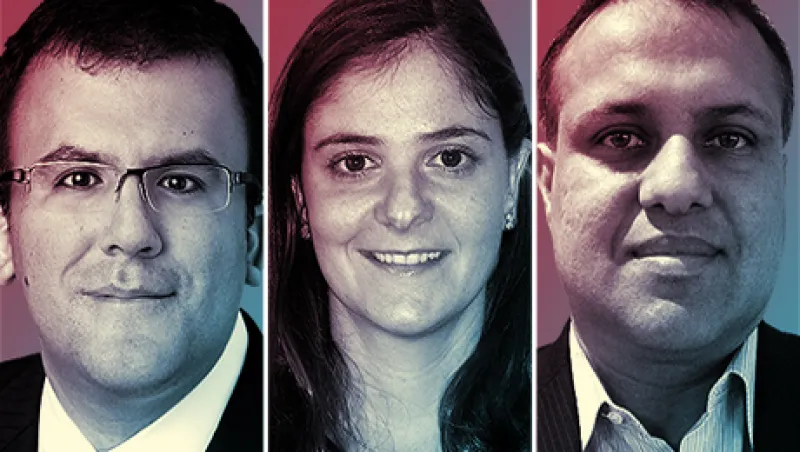Investors began returning to emerging markets in the second quarter, but many have given Latin American equities a miss, opting instead for the region’s robust bond market. Issuance topped $120 billion in 2013 — a record — and market participants expect this year’s total to be only slightly below last year’s. Compare that to the region’s stock markets, most of which ended 2013 in the red and made only modest gains in the first half of this year.
“We expect fixed income to remain in favor relative to equities in the near term,” reports Rodrigo Góes, head of equity research, sales and trading at BTG Pactual in São Paulo. “Yields remain attractive, particularly in Brazil, while regional electoral-related uncertainties coupled with global macro and geopolitical concerns should keep investors underweight riskier assets, such as equities, for a while longer.”
Carlos Constantini, Itaú BBA’s São Paulo–based director of research, echoes that sentiment. “Fixed-income investors are seeking yield, and interest rates in the developed world have remained very low, forcing them to consider alternative investments,” he explains. “On the other hand, equity investors normally look at longer-term outlooks for companies and sectors and need to find encouraging fundamentals to buy stocks.”
The pattern could reverse when U.S. interest rates start to rise or Latin America’s economic growth outlook improves, “but that may not happen in the coming quarters,” he adds. Nonetheless, Constantini sees some cause for optimism: “Colombia and Mexico should do better, based on a clearer fundamental outlook, availability of good bottom-up stories, and accepting that high valuations are a global condition.”
J.P. Morgan’s director of Latin American equity research, Pedro Martins Jr., agrees that regional growth is likely to be subdued through next year but believes Peru offers “an asymmetric positive risk” for equity investors.
“The upside for many domestic-related stocks could be very significant should the country actually grow beyond our base case of 4.2 percent in 2014, driven by credit, retail penetration, infrastructure and formal labor,” says Martins, who is headquartered in São Paulo. “We continue to see resilience in mining investments despite lower commodities prices, given Peru’s significant cost-competitive advantages.”
Finding the right investment opportunities in a region as culturally and economically diverse as Latin America can be a daunting task, and many portfolio managers rely on the sell side for assistance. The firm that provides the most helpful insights in the current climate is J.P. Morgan, which jumps from the No. 3 slot it shared last year with BTG Pactual to lead the 2014 Latin America Research Team, Institutional Investor’s 22nd annual ranking of the region’s best analysts. Its researchers earn a place in 24 of the survey’s 25 sectors, failing to appear only in Agribusiness.
BTG Pactual rises one rung to tie for second place with last year’s winner, Itaú BBA; these firms each claim 22 team positions. Slipping from No. 2 to No. 4 is Bank of America Merrill Lynch, with 21 spots. Two banks capture 16 positions and thus occupy the fifth tier: Credit Suisse, which climbs one level; and Morgan Stanley, which holds steady. These results are based on the views of some 865 investment professionals at more than 450 buy-side institutions that collectively manage an estimated $402 billion in Latin American equities and $271 billion in Latin American debt.
In late July the International Monetary Fund scaled back its global growth forecast and also lowered its projections for Latin America’s major markets. The Washington-based organization expects Brazil’s economy to expand by only 1.3 percent this year — it had earlier predicted 1.9 percent — and by 2 percent in 2015, down from 2.6 percent. Mexico’s real gross domestic product will grow by only 2.4 percent, not the 3 percent the IMF anticipated in April.
“Our view is relatively similar,” Góes attests. “Argentina is already in recession, whereas growth in Brazil, Mexico, Chile and Peru has been slowing down over the past quarters. In Colombia, however, economic activity is gaining traction, mainly thanks to the fact that oil prices remain at high levels.” His analysts are calling for GDP growth in these six countries to average 2.4 percent this year and 3.4 percent in 2015.
Itaú economist Ilan Goldfajn directs teams that finish third in Economics and Sovereign Debt and co-leads, with Ciro Matuo, the No. 1 team in Local-Markets Strategy. Although the São Paulo–based researcher projects a regional recovery in the second half, “growth for full-year 2014 would still be below trend in most countries we cover,” he notes. “Our growth forecast for the region stands at 1.7 percent and 2.8 percent in 2014 and 2015, respectively.”
More-rapid expansions in China and developed markets are among the upside risks, Goldfajn adds, while downside risks include the emergence of inflationary pressures in the U.S. that would tighten financial conditions abroad, reducing capital flows to Latin America.
Góes concurs. “More aggressive than expected U.S. monetary policy tightening could trigger a capital flow reversal and an increase in borrowing costs,” he points out.
Those costs have been a hot topic in the region’s largest economy. In mid-July, Brazil’s central bank held its benchmark Selic rate steady at 11 percent and signaled that it was unlikely to make any changes until after October’s elections. President Dilma Rousseff faces an uphill battle for a second term. As of late July polls showed the Workers Party incumbent with support from roughly 38 percent of likely voters, with challengers Aécio Neves of the Social Democracy Party and Eduardo Campos of the Brazilian Socialist Party winning the backing of 22 percent and 8 percent, respectively. A candidate must win more than 50 percent of the vote to avoid a runoff.
“The central bank took the right decision to maintain interest rates at current levels instead of cutting rates amid a growth slowdown,” believes Emy Shayo Cherman, who pilots the J.P. Morgan team that captures first place for coverage of Brazil. “The low growth and lack of investment of the Brazilian economy at this point is more related to uncertainty and deteriorating expectations about the future than with the level of interest rates.”
The São Paulo–based team leader says the economy is in “deterioration mode” in the final months leading up to the elections. “There aren’t many policy initiatives at this stage that can revert the low-growth trend that has been in place for the past three years,” Cherman says. “The election is likely to go to a second round, and the race is expected to be tight.”
Politics also play a key role in Mexico’s development. Legislators have been hammering out the details of President Enrique Peña Nieto’s plan to open the country’s oil and gas industries to private investment. “We expect Congress to approve the energy secondary laws [ESL] no later than August,” Carlos Peyrelongue predicted in late July. The BofA Merrill researcher co-captains teams in first place for coverage of Mexico, with Carlos Capistran; second and third place, respectively, in Cement & Construction and Real Estate, with Guilherme Vilazante; and runner-up in North Andean Countries, with Francisco Rodríguez. “We expect the ESL to allow private investment in deepwater exploration and shale oil and/or gas, with and without partnerships” with the state-run Petróleos Mexicanos. “Electricity generation should be completely open to private investments,” he adds.
What impact will this have on the Mexican economy? “In terms of GDP we would expect Mexico’s potential economic growth to increase by 1 to 2 percent per year, thanks to the opening of the energy sector,” which will spur oil and gas production, higher consumption and thus higher fiscal revenues for the state, says Peyrelongue, who works out of Mexico City. “Last but not least, we expect the energy reform over the medium term to result in lower electricity costs, thanks to abundant access to cheap gas, which will allow Mexican manufacturing to become even more competitive on a global basis,” he adds.
In the meantime, investors would do well to buy shares of Cemex, which the analysts expect to outperform owing to strong cement volumes in Mexico, South America and the U.S.; and telecommunications services provider América Móvil, “as we expect asset disposals to allow AMX to unlock value and to reduce its current market share to below 50 percent to avoid asymmetric regulation,” Peyrelongue says.
The North Andean region is a tale of two markets. In July, Colombia reported higher-than-expected growth figures for the first quarter — an annualized rate of 6.4 percent, making it the fastest-growing economy in the region and the second-fastest in the world (after China) — while Peru’s central bank lowered its GDP forecast for the year from 5.5 percent to 4.4 percent, largely because of slowing demand for copper, gold and other commodities. Earlier that month its central bank slashed its overnight lending rate by 25 basis points, to 3.75 percent, in an attempt to stimulate growth.
“Easier financing conditions will help but are not enough to turn the cycle in Peru, especially in the context of tighter monetary policies in the U.S.,” asserts Cesar Medina, who captains the Morgan Stanley crew that seizes first place for coverage of North Andean Countries; he also co-leads, with Guilherme Paiva, teams that rank second and runner-up, respectively, for coverage of Chile and Argentina. “We are more constructive about recent stimulus packages that aim to spur investment. However, we are concerned that regional political uncertainty may delay the benefits of government efforts.”
The analysts are more upbeat about Colombia’s prospects. “Progress on infrastructure and the peace process make Colombia one of the two countries in Latin America where we see upside potential in trend growth — the other is Mexico,” says Medina, who works out of New York. “Despite a very attractive macro backdrop, however, the bottom-up situation for equity investors is rather complicated, owing to limited liquidity and high valuations on domestic-oriented stocks.”
Cyclical sectors in Colombia, especially those with exposure to infrastructure, will outperform in the medium term, the researchers contend. In Peru cost efficiency will be key for outperformance, Medina advises. “Companies in the country had been able to afford rapid cost escalation because a robust macro backdrop supported top-line growth,” he observes. “The ongoing slowdown means firms that deliver the most on efficiency gains should do better than the rest.”
Chile’s economy is also running out of steam. In mid-July the nation’s budget director, Sergio Granados, lowered his 2014 growth forecast from 3.4 percent to 3.2 percent. That was hardly surprising to BTG Pactual’s Alonso Aramburú and César Pérez-Novoa, who lead the team in first place for coverage of that country. They also together direct the No. 2 team in North Andean Countries. Aramburú, with Eduardo Rosman, guides runner-up squads in the two Financials sectors, Banks and Nonbanks; while Pérez-Novoa, with Edmo Chagas, co-captains the No. 2 crew in Pulp & Paper and the No. 3 team in Metals & Mining.
“We have been flagging to investors since late 2013 that Chilean economic growth will be subpar potential, given a sharp contraction in gross capital formation and a slowdown in private consumption, which is reflected in consumer and business sentiment,” says Santiago-based Pérez-Novoa. The analysts’ GDP forecast is even lower than the government’s; they predict expansion of just 2.5 percent this year.
But even here there are opportunities for shrewd investors. “In an environment of higher inflation, we prefer banks, which are protected and leverage from this scenario,” he explains. “This industry is highly disciplined, so the weakness in the overall economy won’t dent margins.”






